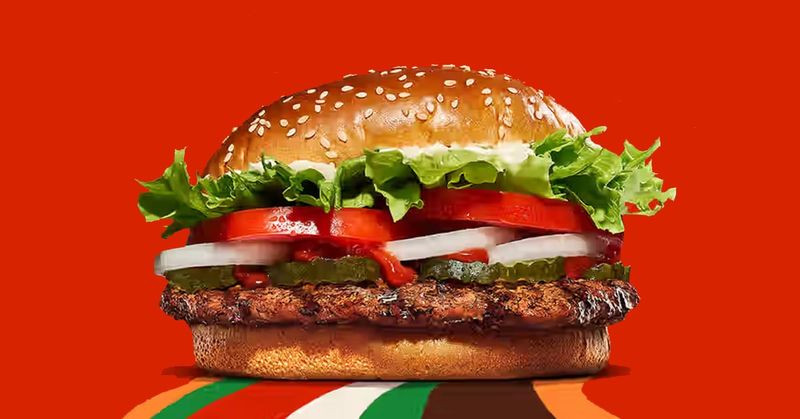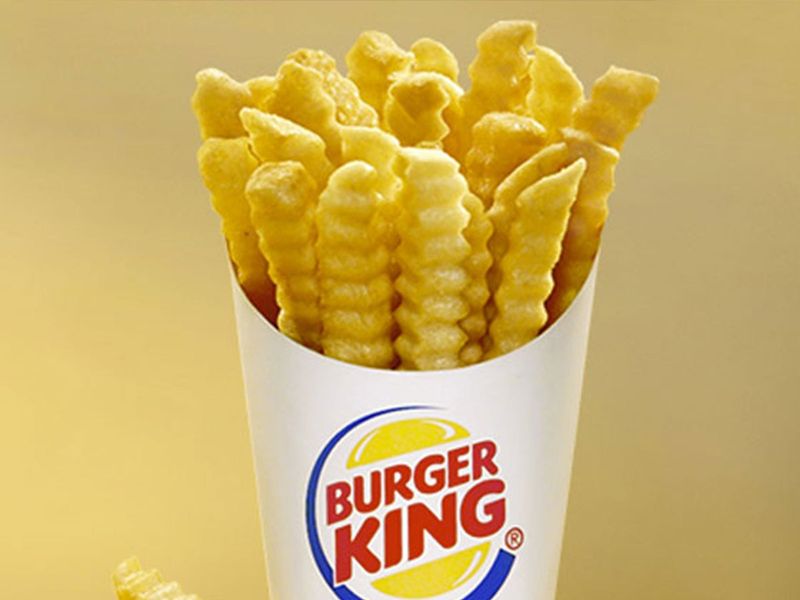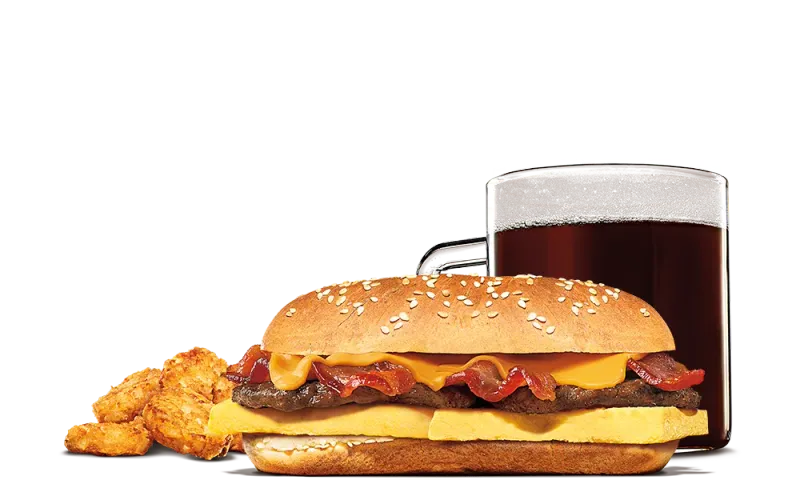Burger King’s menu has been a rollercoaster of culinary innovation, with some items becoming instant classics while others faded into obscurity. This post delves into six standout successes and six unfortunate missteps that have defined the fast-food giant’s journey. From creative concoctions that captured hearts (and taste buds) to experimental offerings that missed the mark, the burger chain’s menu history is as flavorful as it is fascinating. Let’s explore the hits and misses that have shaped Burger King’s identity and learn from their flavorful experiments.
Whopper

The Whopper is Burger King’s crown jewel, a flame-grilled masterpiece that has delighted customers since 1957. With its juicy beef patty, fresh lettuce, tomatoes, and onions, this burger is a symphony of flavors. The sesame seed bun adds a delightful crunch, making each bite an experience. Did you know the Whopper was inspired by a larger-than-life idea to outsize competitors’ offerings? It’s no wonder this iconic burger remains a favorite, a testament to Burger King’s ability to create lasting culinary delights. A true classic, the Whopper embodies the essence of fast-food excellence.
Chicken Fries

With their playful shape and crispy texture, Chicken Fries are a fun twist on traditional chicken nuggets. Originally launched in 2005, they quickly became a fan favorite. The seasoned breading provides a delightful crunch that pairs perfectly with the tender chicken inside. They’re not just for kids; adults love them too. The unique packaging adds convenience, making them an ideal snack on the go. Chicken Fries showcase Burger King’s knack for innovation, offering something different yet familiar. It’s a prime example of fast food done right, blending creativity with classic appeal.
Impossible Whopper

In a bold move towards sustainability, Burger King introduced the Impossible Whopper in 2019. This plant-based alternative offers all the flavor of the classic Whopper without the meat. The innovation lies in its realistic texture and taste, satisfying vegetarians and meat-eaters alike. It’s a step forward in inclusive eating, catering to diverse dietary preferences. The Impossible Whopper proves that plant-based doesn’t mean compromising on taste. It’s a green revolution in fast food, reflecting a growing trend towards healthier, environmentally-conscious choices. A trailblazer, it shows Burger King’s forward-thinking spirit.
Onion Rings

Burger King’s Onion Rings are a beloved side dish, offering a crunchy exterior and sweet onion inside. They provide a tasty alternative to the traditional French fry, adding variety to any meal. Perfectly seasoned and fried to golden perfection, they pair well with a range of dipping sauces. Since their introduction, they have remained a staple on the menu, cherished for their unique taste and satisfying texture. Onion Rings are a testament to Burger King’s ability to create enduring side items that complement their main offerings. They elevate any meal with their distinctive flavor.
Bacon King

The Bacon King is a carnivore’s delight, stacking multiple layers of crispy bacon on top of a juicy beef patty. Introduced as a premium offering, it boasts generous amounts of melted cheese and a toasted bun, creating a mouthwatering combination. This indulgent burger is not for the faint of heart but for those who crave bold flavors. The Bacon King exemplifies Burger King’s flair for creating over-the-top, satisfying meals. It embodies the spirit of indulgence, celebrating everything we love about bacon in a single, formidable sandwich. Truly, it’s a king among burgers.
Rodeo Burger

The Rodeo Burger is a creative twist on the traditional cheeseburger, featuring crispy onion rings and tangy BBQ sauce. This combination adds a new dimension of flavor, transforming an ordinary burger into something extraordinary. Initially launched as a limited-time offer, its popularity has often brought it back to the menu. The Rodeo Burger demonstrates Burger King’s ability to innovate by adding unique elements to classic items. It’s a delightful option for those seeking a bit of adventure with their meal, blending sweet and savory in a way that’s both exciting and satisfying.
Satisfries

Satisfries were Burger King’s attempt to offer a healthier alternative to traditional fries, featuring a unique crinkle-cut design. Launched in 2013, they promised fewer calories and less fat. Despite the healthier profile, customers missed the familiar taste and texture of regular fries. Satisfries were an innovative idea, yet they failed to capture long-term interest. Many felt they lacked the indulgent satisfaction expected from fast food. Ultimately, they were discontinued, serving as a reminder that health-focused innovations must still appeal to traditional taste expectations. A noble effort, but not quite a lasting success.
Enormous Omelette Sandwich

The Enormous Omelette Sandwich was Burger King’s foray into breakfast, offering a hearty start to the day. Packed with eggs, sausage, bacon, and cheese, it was an ambitious creation. Despite its filling nature, it was criticized for being excessively large and unhealthy. Introduced in 2005, it faced backlash for its caloric content. The sandwich was eventually discontinued, illustrating the challenge of balancing indulgence with nutrition. It remains a part of Burger King’s experimental history, highlighting the brand’s willingness to push boundaries. An oversized attempt that perhaps went a bit too far for the breakfast crowd.
Cheesy Tots

Cheesy Tots, small bites of potato filled with gooey cheese, were a playful addition to Burger King’s menu. Initially launched as a limited-time offer, their nostalgic appeal brought them back several times. Despite their fanbase, they couldn’t maintain a permanent spot. These tots showcased Burger King’s inventive side, merging childhood favorites into a tasty treat. However, the inconsistency in availability left fans wanting more. While they provided a delightful burst of flavor, they struggled to cement their place. Cheesy Tots remind us of the delicate balance needed to sustain new menu items amid changing tastes.
Angry Whopper

The Angry Whopper was Burger King’s fiery take on the classic, adding jalapenos, spicy sauce, and crispy onions. Launched as a bold offering, it aimed to entice those who craved heat. While it delivered on spice, some found it overwhelming, detracting from the burger’s overall appeal. The Angry Whopper illustrates the challenge of balancing bold flavors with customer expectations. Though it had its fans, it struggled to maintain a lasting presence, ultimately fading from the menu. A spicy experiment, the Angry Whopper reminds us that too much heat can sometimes overshadow taste.
Mac n’ Cheetos

Mac n’ Cheetos were an adventurous blend of mac and cheese and crunchy Cheetos, offering a unique snacking experience. Introduced in 2016, they sparked curiosity with their bold concept. However, the execution left some unimpressed, with reviews noting uneven flavors. While innovative, they didn’t capture the enduring appeal needed for success. Despite their initial buzz, they were eventually phased out. Mac n’ Cheetos serve as a testament to Burger King’s willingness to experiment, even if it means taking a risk. This quirky item reflects the brand’s playful side, though it wasn’t a permanent hit.
BK Veggie

The BK Veggie was Burger King’s first major attempt to cater to vegetarians, featuring a garden veggie patty. Launched in the early 2000s, it provided an alternative to meat-based burgers. However, it faced criticism for its bland taste and texture. Despite its good intentions, the BK Veggie struggled to win over customers, overshadowed by more flavorful offerings. Its eventual discontinuation highlighted the challenge of executing vegetarian options that satisfy discerning palates. The BK Veggie was a step towards inclusivity but lacked the innovation needed to thrive. An early attempt that paved the way for future plant-based initiatives.
Leave a comment